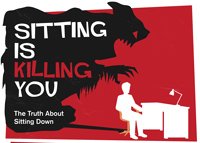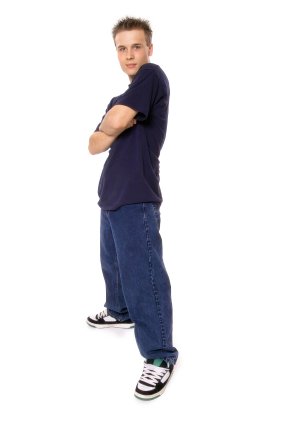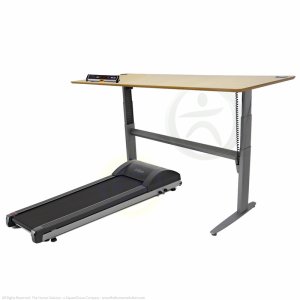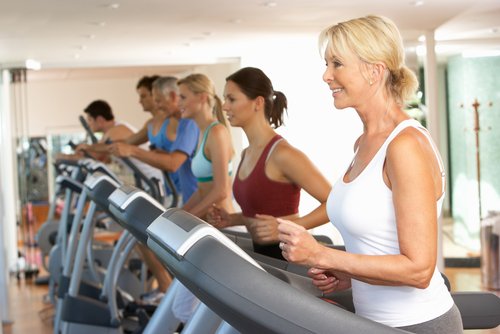Desk Work: Sit? Stand? Both?
In the modern debate about whether to sit, stand or jiggle behind your desk all day, there is little examination of how we might improve our base positions as opposed to escape them.  “The best position is the next position” exemplifies the common admission of hopelessness in finding any healthy base position.
“The best position is the next position” exemplifies the common admission of hopelessness in finding any healthy base position.
In my view, all base positions have merits, and done with good form in moderation, are healthy and sustainable. Let us examine how we might improve each of our desk positions.
Sitting
The act of sitting has come under the gun in recent years. There are studies showing that sitting for extended periods of time, even when supplemented with sporadic exercise, does lasting damage to a person’s health. But people have sat for millennia, weaving baskets, sewing clothes, preparing meals, and talking story. Might it be that the way we sit is a key determiner in just how bad sitting is for us? Most people today slump or tense as they sit – this severely compromises circulation, breathing and digestion as well as musculoskeletal health. With stacksitting and stretchsitting, the health profile of sitting looks quite different. It would be interesting to see a study done on people who more closely approximate our ancestors in their sitting form and who also incorporate a more traditional pattern of breaking to stand, walk (maybe dance?)
In any case, some things just need to be done  sitting – sharing a meal with your family, nursing your baby, relaxing with a movie, or travelling by car, plane or bus. Most of us find that clearer, deeper and more focused thinking is possible when we sit, and that we are less distracted when not having to navigate the physical world around us.
sitting – sharing a meal with your family, nursing your baby, relaxing with a movie, or travelling by car, plane or bus. Most of us find that clearer, deeper and more focused thinking is possible when we sit, and that we are less distracted when not having to navigate the physical world around us.
So, rather than abandoning or feeling guilty about sitting, I suggest we improve our form when we have to or want to sit. And maybe sitting, like some other previously maligned activities like exposure to sun and consuming fat, will turn out to have some overlooked benefits and/or be good if done in a healthy fashion.
We refer you to the techniques of stretchsitting:
http://www.youtube.com/watch?v=n9CDhcVTAdc
and stacksitting:
http://www.youtube.com/watch?v=vkWtO6He7VM
Standing
Standing has come in favor amongst the ergo pundits of the day. Unfortunately most people are not comfortable standing for long periods of time. Their feet or backs hurt, they develop varicose veins, or they get tired. Most people can relate to not being comfortable for long periods of time spent standing in museums.
In fact, the most common ways of standing with locked  knees and groin and weight thrust forward on the foot, damage not only the feet, knees and hips, but the entire spine through the neck. The exaggerated spinal curves that result from a forward thrust and tucked pelvis threaten every disc and spinal nerve root in the body, with the cervical and lumbar levels being the most vulnerable.
knees and groin and weight thrust forward on the foot, damage not only the feet, knees and hips, but the entire spine through the neck. The exaggerated spinal curves that result from a forward thrust and tucked pelvis threaten every disc and spinal nerve root in the body, with the cervical and lumbar levels being the most vulnerable.
The example of the Inuit seal hunter  is inspiring in this context. He has to stand for long periods without moving (to not frighten away prey) in extreme weather conditions. And he isn’t tired, achy or damaged from this. Standing can be done for long periods!
is inspiring in this context. He has to stand for long periods without moving (to not frighten away prey) in extreme weather conditions. And he isn’t tired, achy or damaged from this. Standing can be done for long periods!
Tallstanding, as we teach it, is one of the more challenging things to learn from a book or even DVD. When we teach this technique in our Foundations course, it takes several lessons for people to accept that the strange-feeling new way of being upright is not orangutan-esque and ridiculous. It takes looking in a mirror to convince most students that though they feel weird, they don’t look weird (and that in fact they look better than usual!) So for this technique, beyond studying 8 Steps and the DVD Back Pain: The Primal Posture Solution, we refer you to our basic course, where standing is first introduced in Lesson 3 of six lessons.
Treadmill desks
The latest trend in office furniture includes  exercise machines. Workers are encouraged to walk or jog on treadmills while they push the company agenda forward.
exercise machines. Workers are encouraged to walk or jog on treadmills while they push the company agenda forward.
Whereas it is clearly better to have exercise than not, I wonder whether we wouldn’t be better off encouraging people to walk, run and move from time to time for selected work tasks rather than simulating those behind a desk in an office setting.  And I wonder whether it isn’t critical that, whether the jogging and exercising is done behind a desk or away from it, it be done in a posture-friendly manner.
And I wonder whether it isn’t critical that, whether the jogging and exercising is done behind a desk or away from it, it be done in a posture-friendly manner.
At home, my family has a table tennis table parked in the living room that my husband and I use for breaks from work or for work-related discussions. I find it helps on many levels – it provides whole body exercise (it provides stretch, strength, cardiovascular stimulation), mental stimulation, eye-hand co-ordination, competitive edge (testosterone zip?), and plain fun and connection.
For some of my long distance meetings, I walk the neighborhood with my cell phone and headphones (thank you, modern technology).
 With one of my colleagues I often turn on Brazilian music and “meet” over dance. Again, the benefits are numerous and diverse. I hope one day to influence more corporations to encourage posture-friendly dance-outs. I think they would provide a perfect complement to the gravity of the work environment.
With one of my colleagues I often turn on Brazilian music and “meet” over dance. Again, the benefits are numerous and diverse. I hope one day to influence more corporations to encourage posture-friendly dance-outs. I think they would provide a perfect complement to the gravity of the work environment.
Meanwhile, in writing this newsletter, I’m glad to have a regular desk, a comfortable chair and my thoughts focused and uncluttered. I edited the newsletter doing a little samba at my kitchen counter. I’d love to hear about your experiments in working, moving and getting comfortable.
Best,
Esther

Comments
As I am quite tall and can
As I am quite tall and can never find the right desk set up. I have taken to sitting cross legged on the floor with my laptop resting on a chair seat or stool in front of me. This keeps my spine in good J alignment, my shoulders back and my elbows low and stops me from hunching forward. I'm a freelancer and travel a lot, so there is rarely a decent chair or desk set up I can use. Are there any issues with working in this way? Thanks!
The problem is usually that
The problem is usually that people from modern industrialized cultures rarely have the ability to sit upright and relaxed crosslegged on the floor - they either relax and slump forward or are upright and tense, each of which causes problems. Try sitting on a zafu (round meditation cushion) to help make up for what your hips may not be able to do. Or surprise us with a picture of you sitting perfectly at your floor/chair arrangement!
An option that usually works is to stacksit on the edge of the chair (if you're tall you'll probaby have to fold your legs under or way ahead of the chair) - that's the most versatile type of healthy sitting.
Good luck!
Thanks so much for your
Thanks so much for your advice, that's really helpful. My posture is better in this position than in most chairs, but I do notice that after a period I will feel a bit tense in my hips and mid back so I will definately try the zafu. I think stacksitting could be a great solution. I just bought your book so looking forward to reading up on it.
I have the same issue: I'm 6
I have the same issue: I'm 6'5" and uncomfortable in every chair at work. Is your Gokhale Chair adjustible for my height?
Yes, but state clearly what
Yes, but state clearly what yor height is and that you want a tall chair.
Add New Comment
Login to add commment
Login